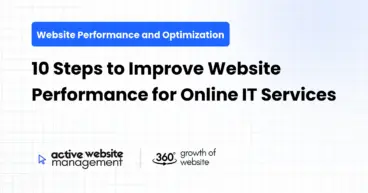December 26, 2024
8 min read
In today’s digital world, having a website that runs efficiently and provides a seamless experience for users is crucial for success. A website that is slow, unresponsive, or difficult to navigate can significantly harm user engagement, SEO rankings, and ultimately, your business. That’s where website performance audits come in. By regularly auditing your website’s performance, you can identify bottlenecks, optimize speed, and ensure a smooth browsing experience.
In this article, we will explore the top 7 tools for effective website performance audits. These tools not only help evaluate your website’s speed and performance but also provide insights into areas that need improvement. We will also look at best practices for conducting performance audits and maintaining an efficient website.
A website performance audit is a comprehensive evaluation of a website’s load times, responsiveness, and overall user experience. The goal is to ensure that the website performs optimally across all devices and browsers, ensuring users have a fast and enjoyable experience.
During a website audit, different factors are analyzed, including:
- Page load times: How fast your site loads on various devices and networks.
- Performance bottlenecks: Areas where your site is slow or inefficient.
- SEO performance: How well your site ranks in search engines, including page speed and mobile friendliness.
- Security: Ensuring the website is secure, including HTTPS implementation and vulnerability checks.
- User experience (UX): Evaluating design, ease of navigation, and mobile responsiveness.
Now that we understand the importance of website audits, let’s dive into the top 7 tools you can use to effectively conduct performance audits.
1. Google PageSpeed Insights
Overview of Google PageSpeed Insights
Google PageSpeed Insights is one of the most popular tools for evaluating website performance. This free tool analyzes the content of a web page and generates suggestions to improve its speed and overall performance.
Don’t Just Maintain Your Website—
Grow It using Active Website Management! Don't Wait for Growth—Accelerate It with Active Website Management
Key Features
- Mobile and desktop performance analysis: It provides separate insights for both mobile and desktop versions of your website.
- Suggestions for improvement: It gives specific recommendations for improving performance, such as image optimization, reducing server response time, and more.
- Core Web Vitals data: Google uses Core Web Vitals (such as Largest Contentful Paint, First Input Delay, and Cumulative Layout Shift) to assess a page’s user experience.
How to Use It Effectively
To get the best out of PageSpeed Insights, ensure you are regularly monitoring both the mobile and desktop versions of your website. Since Google uses mobile-first indexing, it is especially important to optimize your mobile site performance.
2. GTmetrix
Overview of GTmetrix
GTmetrix is another popular tool for website performance audits. It provides detailed reports on your site’s loading times, page size, and number of requests made. It also offers actionable insights for improving website speed.
Key Features
- Page speed score: GTmetrix gives you an overall score based on the performance of your page.
- Waterfall chart: The tool provides a detailed breakdown of how long each element of your website takes to load, helping you identify bottlenecks.
- Performance history: It tracks the performance of your website over time, which helps you understand the impact of any changes you make.
How to Use It Effectively
You can set up alerts in GTmetrix to track your website’s performance continuously. This allows you to monitor changes over time and quickly address any performance dips.
3. Lighthouse
Overview of Lighthouse
Lighthouse is an open-source, automated tool developed by Google that helps developers with auditing website performance, accessibility, and SEO. It’s particularly useful for in-depth performance analysis.
Key Features
- Comprehensive audits: Lighthouse provides detailed audits in areas like performance, accessibility, SEO, and best practices.
- Real-time reports: You can run audits directly in Chrome DevTools or as a standalone tool.
- Performance benchmarks: Lighthouse sets specific benchmarks for performance, such as the time to interactive (TTI), and helps you compare your site against these benchmarks.
Don't Wait for Growth—Accelerate It with
Active Website Management Don't Wait for Growth—Accelerate It with Active Website Management
How to Use It Effectively
Lighthouse is perfect for developers and advanced users who want detailed insights into website performance. You can run audits directly from Chrome’s Developer Tools or integrate it into your workflow via Node.js.
4. Pingdom
Overview of Pingdom
Pingdom is a powerful website monitoring tool that provides detailed reports about website performance. It tracks your site’s uptime, performance, and user interactions.
Key Features
- Performance monitoring: Pingdom checks your website’s performance from multiple locations around the world.
- Detailed reports: It breaks down page load time and helps identify the cause of slowdowns (e.g., large images, excessive requests).
- Uptime monitoring: It tracks whether your website is available and alerts you if there are any downtimes.
How to Use It Effectively
Pingdom is best for tracking long-term website performance and monitoring your website’s uptime. If you have a global audience, Pingdom’s multiple server locations for testing are especially useful for understanding the user experience from different regions.
5. WebPageTest
Overview of WebPageTest
WebPageTest is a free tool that provides detailed insights into how a webpage loads. It offers valuable information on load times, bottlenecks, and performance suggestions.
Key Features
- Multiple test locations: WebPageTest allows you to test your website’s performance from different global locations and devices.
- Advanced metrics: You can view detailed information on Time to First Byte (TTFB), First Contentful Paint (FCP), and more.
- Filmstrip view: This unique feature lets you watch a visual representation of how the page loads, making it easy to spot issues.
How to Use It Effectively
WebPageTest is especially helpful for developers and those who want granular insights into their website’s load performance. It’s perfect for identifying issues like render-blocking JavaScript or large media files that slow down your website.
6. Screaming Frog
Overview of Screaming Frog
Screaming Frog is a website crawler and SEO audit tool that helps you analyze your website’s performance from an SEO perspective. It’s particularly useful for technical SEO audits, including site speed analysis.
Key Features
- Crawl analysis: Screaming Frog can crawl your entire website to find issues like broken links, duplicate content, and slow-loading pages.
- Page speed data: It collects data about the performance of individual pages, helping you identify slow-loading pages and performance bottlenecks.
- Integration with Google Analytics: You can integrate Screaming Frog with Google Analytics to get a more complete view of your site’s performance.
How to Use It Effectively
Screaming Frog is ideal for large websites that need in-depth analysis. Use it to find technical issues, optimize site structure, and improve your website’s load times.
7. YSlow
Overview of YSlow
YSlow is a performance analysis tool created by Yahoo. It analyzes web pages based on a set of performance rules and suggests optimizations to improve page load times.
Key Features
- Performance grade: YSlow assigns a performance grade (A to F) based on the results of its analysis.
- Rule-based recommendations: YSlow provides specific recommendations based on a set of rules designed to improve page performance (e.g., image compression, caching headers).
- Browser extension: YSlow is available as a browser extension, making it easy to analyze pages while browsing.
How to Use It Effectively
YSlow is especially useful for front-end developers looking for performance improvements. It’s a simple tool that gives quick insights and actionable steps to enhance your site’s speed.
Active Website Management for Continuous Optimization
What Is Active Website Management?
Active website management is the ongoing process of monitoring, maintaining, and optimizing your website to ensure that it remains fast, secure, and functional. This process involves conducting regular performance audits, updating content, ensuring security patches are applied, and making sure the site works well across different devices.
Importance of Active Website Management
Regular audits and continuous optimization help ensure that your website performs well over time, adapts to new technologies, and maintains its competitive edge. Active website management helps prevent issues before they become critical and ensures that your website remains in top shape.
Key Aspects of Active Website Management
- Regular Performance Audits: Make it a habit to regularly perform website performance audits using the tools mentioned above. This helps you identify performance issues early and take corrective action.
- Content Updates: Regularly update your website content to keep it fresh and relevant. Search engines favor websites with new, engaging content.
- Security Monitoring: Ensure that security patches and updates are applied to prevent vulnerabilities.
- User Experience Testing: Continuously monitor user behavior and tweak your website’s design and navigation to improve the user experience.
Conclusion
Regular website performance audits are essential to maintaining a fast, secure, and user-friendly site. The seven tools mentioned in this article—Google PageSpeed Insights, GTmetrix, Lighthouse, Pingdom, WebPageTest, Screaming Frog, and YSlow—are invaluable for identifying issues and providing insights on how to improve your site’s performance.
By using these tools and engaging in active website management, you can ensure that your website remains optimized, user-friendly, and ready to meet the needs of your audience.






